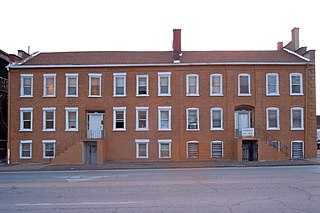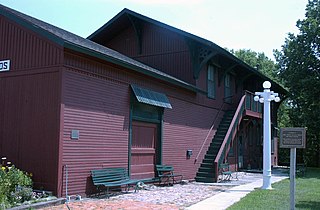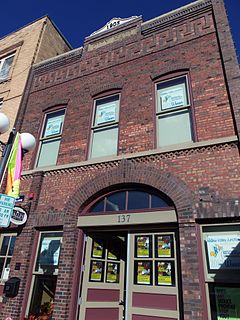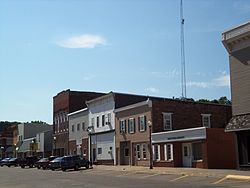
U.S. Route 66 in the state of Texas extended across the Texas Panhandle from its designation in 1926 to its decommissioning in 1985.

The Oregon Commercial Historic District is a historic district in Oregon, Illinois, that has been listed on the National Register of Historic Places since 2006. The district is roughly bordered by Jefferson, Franklin, 5th and 3rd Streets in Oregon. It is one of six Oregon sites listed on the National Register and one of three to be so listed since the turn of the 21st century. The other two are the Oregon Public Library, listed in 2003, and the Chana School, listed in 2005.

Davenport Bank and Trust Company was for much of the 20th century the leading bank of the Quad Cities metropolitan area and the surrounding region of eastern Iowa and western Illinois. It was at one time Iowa's largest commercial bank, and the headquarters building has dominated the city's skyline since it was constructed in 1927 at the corner of Third and Main Streets in downtown Davenport, Iowa. It was acquired by Norwest Bank of Minneapolis in 1993 and now operates as part of Wells Fargo following a 1998 merger of the two financial institutions. The historic building was listed on the National Register of Historic Places in 1983 under the name of its predecessor financial institution American Commercial and Savings Bank. In 2016 the National Register approved a boundary increase with the Davenport Bank and Trust name. It was included as a contributing property in the Davenport Downtown Commercial Historic District in 2020. It remains the tallest building in the Quad Cities, and is today known as Davenport Bank Apartments as it has been redeveloped into a mixed-use facility housing commercial, office and residential space.

The Scott County Jail is the main detention facility for Scott County, Iowa, United States. Inmates are housed for no more than one year, by Iowa law. It is located in the county seat, Davenport, and is part of same facility as the Scott County Courthouse.

The Burtis–Kimball House Hotel and the Burtis Opera House were located in downtown Davenport, Iowa, United States. The hotel was listed on the National Register of Historic Places in 1979. It has since been torn down and it was delisted from the National Register in 2008. The theatre building has been significantly altered since a fire in the 1920s. Both, however, remain important to the history of the city of Davenport.

The Hiller Building, also known as the Schick Apartments, is located on the edge of downtown Davenport, Iowa, United States. The Federal style building is a row house. It was individually listed on the National Register of Historic Places in 1974. In 1983 it was included as a contributing property in the West Third Street Historic District.

Chicago, Rock Island and Pacific Railroad-Wilton Depot is an historic building located in Wilton, Iowa, United States. The Mississippi and Missouri Railroad built the first rail line in 1855 in what would be called Wilton Junction. The railroad became the Chicago, Rock Island and Pacific Railroad (CRI&P) a few years later. A wooden frame depot and a separate freight facility served the community. The railroad placed their repair and maintenance center in Wilton, and it remained here until 1881 when they started to move operations to Davenport and Muscatine. Rail service continue to increase along the CRI&P, which necessitated a new depot in Wilton. This single-story, brick Romanesque Revival structure was completed in 1898. Six passenger trains stopped in Wilton in 1911, and by 1922 same-day service to and from Chicago began. While the number of freight trains passing through town numbered five or six by 1947, the number of passenger trains declined to one in 1948. The depot received part-time service from 1963 to 1974, when the depot closed.

Edward Hammatt was an architect in the United States. He designed several notable buildings that are listed on the National Register of Historic Places.

The West Liberty Commercial Historic District in West Liberty, Iowa, United States, is a historic district that was listed on the National Register of Historic Places in 2002. At that time, it included 41 contributing buildings, six other contributing structures, and eight non-contributing buildings.

The Burlington, Cedar Rapids, and Northern Railroad-Rock Rapids Station, Railroad Track and Bridge is a nationally recognized historic district located in Rock Rapids, Iowa, United States. It was listed on the National Register of Historic Places in 1976. At the time of its nomination the district included one contributing building and three contributing structures.

The Waverly East Bremer Avenue Commercial Historic District is a nationally recognized historic district located in Waverly, Iowa, United States. It was listed on the National Register of Historic Places in 2014. At the time of its nomination it contained 53 resources, which included 41 contributing buildings, and 12 non-contributing buildings. The historic district covers a portion of the city's central business district between the Cedar River on the west and the former right-of-way for the Chicago Great Western Railway on the east.

The Mills Tower Historic District is a nationally recognized historic district located in Iowa Falls, Iowa, United States. It was listed on the National Register of Historic Places in 1990. At the time of its nomination the district consisted of six resources, including two contributing buildings, and four non-contributing buildings. All of the buildings are associated with the Illinois Central Railroad (IC). The Dubuque & Sioux City Railroad, an affiliate of the IC, laid the first rail track to Iowa Falls in 1866. The following year the Iowa Falls & Sioux City Railroad, another IC affiliate, continued construction of the line to the west, and it reached Sioux City by 1870. The Burlington, Cedar Rapids and Northern Railway (BCR&N) by way of its affiliate the Cedar Rapids, Iowa Falls & North Western, entered Iowa Falls in 1880. Two years later it was expanded to the north and intersected with the IC main line, which required a controlled crossing. Little is known about this first crossing and what it contained.

The Oxford Commercial Historic District is a nationally recognized historic district located in Oxford, Iowa, United States. It was listed on the National Register of Historic Places in 1997. At the time of its nomination it consisted of 20 resources, which included 16 contributing buildings and four non-contributing buildings. This district reflects a typical central business district found in a Midwest town. It represents a transitional period from a frontier town to a settled community, and from the horse as the primary means of transportation to the automobile and mechanized farming. Most of the buildings in Oxford's business district were constructed between 1883 and 1917. Some replaced the wood frame structures from the town's frontier days, while others replaced those destroyed by a major fire that consumed the north side of the district in 1890. They are one to two stories in height, and their exteriors are composed of common brick. While simple in composition, many feature ornate decorative cornices. The Italianate and Romanesque Revival styles dominate.

The Marion Commercial Historic District is a nationally recognized historic district located in Marion, Iowa, United States. It was listed on the National Register of Historic Places in 2009. At the time of its nomination it consisted of 41 resources, which included 29 contributing buildings, one contributing site, one contributing structure, two contributing objects, and eight non-contributing buildings. The historic district covers the city's central business district. The development of this area largely occurred when Marion was the county seat of Linn County (1838-1919). There are no county government buildings extant from this era. The city was also a division point for the Chicago, Milwaukee, St. Paul and Pacific Railroad in the late nineteenth and early twentieth centuries.

The Valley Junction-West Des Moines City Hall and Engine House is a historic building located in West Des Moines, Iowa, United States. Valley Junction was incorporated in 1893, and it was named for the junction of three lines of the Chicago, Rock Island and Pacific Railroad where it was located. This two-story brick building was constructed to house the community's city hall and fire station, even though the fire department would not be established until 1905. The fire station was located on the first floor, and the city hall was located on the second floor. It was located a block north of the train depot. An interurban railway connected the town to Des Moines, and its proximity to the Iowa coal fields contributed to its growth. By 1911 the town grew to be the second largest community in Polk County, and its name was changed to West Des Moines by 1940. The building was used for city hall until 1952. It was individually listed on the National Register of Historic Places in 1983. It was included as a contributing property in the Valley Junction Commercial Historic District in 2017.

The Valley Junction Commercial Historic District is a nationally recognized historic district located in West Des Moines, Iowa, United States. It was listed on the National Register of Historic Places in 2017. At the time of its nomination it consisted of 72 resources, which included 53 contributing buildings, 17 non-contributing buildings, and two non-contributing structures. What is now the city of West Des Moines was incorporated as Valley Junction in 1893. Its central business district, which is the subject of this historic district, developed near the depot of the Chicago, Rock Island and Pacific Railroad. The railroad also had their shops (non-extant) to the southwest of the district in an angle formed by the junction. The linear historic district is composed of most of three blocks of Fifth Street and parts of two cross streets.

The Colfax Spring City Commercial Historic District is a nationally recognized historic district located in Colfax, Iowa, United States. It was listed on the National Register of Historic Places in 2018. At the time of its nomination it contained 48 resources, which included 28 contributing buildings, two contributing sites, two contributing structures, 12 non-contributing buildings, and four non-contributing structures. Colfax was platted in 1866 or 1867 as a railroad and farm-to-market town along the Chicago, Rock Island and Pacific Railroad. Coal mines were also located to the south of town. Mineral water was discovered in the area in 1875, which led to the development of the mineral water-based health industry in Colfax. The historic district represents the growth during this time period. After the health-related mineral water industry declined, Colfax expanded its farm-to-market economy in the late inter-war and post-World War II years.

The Davenport Motor Row and Industrial Historic District is a nationally recognized historic district located on the eastern edge of downtown Davenport, Iowa, United States. It was listed on the National Register of Historic Places in 2019. At the time of its nomination it consisted of 28 resources, which included 21 contributing buildings, one contributing site, one contributing structure, and five non-contributing buildings. The area was previously a part of the notorious Bucktown, a district of saloons, beer gardens, brothels, billiard parlors, gambling establishments, and theaters. Davenport licensed prostitution in 1893, gambling in 1904, and failed to enforce Iowa prohibition laws during this period. A crusade against vice by Davenport's Catholic bishop, Henry Cosgrove, and reforms by state leaders led to the district's transformation in the early 20th century into a light industrial area. The city's automobile industry settled here beginning in the 1910s. They stayed until the mid-20th century when Interstate 80 was completed on the north side of the city and they moved to the suburban areas. U.S. Route 32 and its successor U.S. Route 6 passed through the district on East Second Street from 1926 to 1937. The Government Bridge (1896), which for years was the city's only bridge across the Mississippi River, is immediately adjacent to the district.

The Davenport Downtown Commercial Historic District is a nationally recognized historic district located in the central business district of Davenport, Iowa, United States. It was listed on the National Register of Historic Places in 2020. At the time of its nomination it consisted of 43 resources, which included 33 contributing buildings, one contributing structure, and nine non-contributing buildings. In addition, the district also contains 33 buildings that are individually listed on the National Register. This historic district is bordered by four other districts: the Crescent Warehouse Historic District and the Davenport Motor Row and Industrial Historic District on the east, the Hamburg Historic District to the northwest, and the West Third Street Historic District on the west.

The Ijem Avenue Commercial Historic District is a nationally recognized historic district located in Nichols, Iowa, United States. It was listed on the National Register of Historic Places in 2020. It is composed of 12 one and two-story commercial buildings that date from the late nineteenth to the mid-twentieth century. It also includes one modern infill building. Nichols is a small town in western Muscatine County and was an important railroad shipping point and market town from about 1885 to about 1920. It was located along the Burlington, Cedar Rapids and Northern Railway, which came to town in 1871, and the Muscatine and Western Railroad, which arrived two years later. The two railroads intersected on the west side of the central business district, and both were incorporated into the Chicago, Rock Island and Pacific Railroad in the 1880s. The brick commercial buildings in the historic district were built during this period of time. They are attached one and two-story brick structures. The oldest buildings reflect the Italianate style with their arched windows, while the later buildings reflect the Neolassical and Commercial styles.























